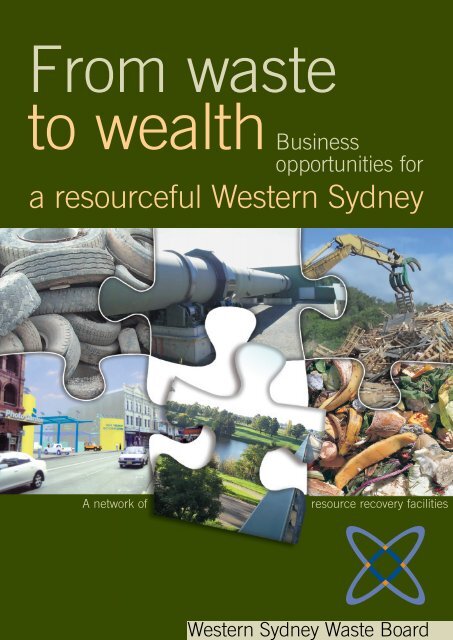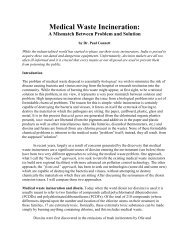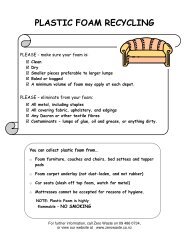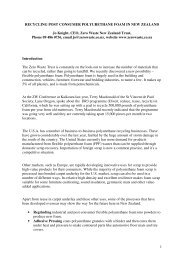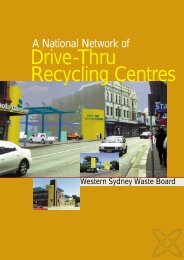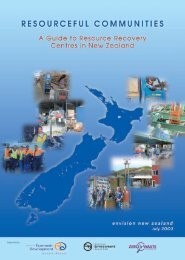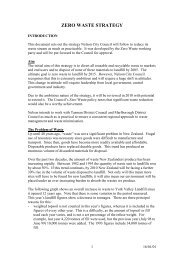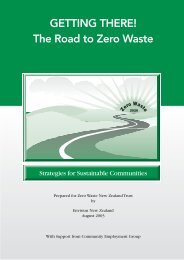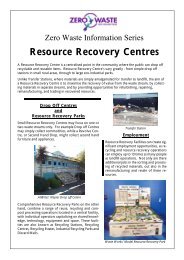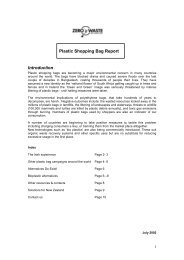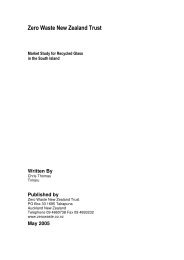From waste to wealth - Zero Waste
From waste to wealth - Zero Waste
From waste to wealth - Zero Waste
You also want an ePaper? Increase the reach of your titles
YUMPU automatically turns print PDFs into web optimized ePapers that Google loves.
Western Sydney <strong>Waste</strong> Board<br />
<strong>From</strong> <strong>waste</strong><br />
<strong>to</strong> <strong>wealth</strong><br />
Business<br />
opportunities for<br />
a resourceful Western Sydney<br />
A network of<br />
resource recovery facilities
<strong>From</strong> <strong>waste</strong><br />
<strong>to</strong> <strong>wealth</strong><br />
Business opportunities for a<br />
resourceful Western Sydney<br />
The Western Sydney <strong>Waste</strong> Board (WSWB) has a vision <strong>to</strong> give Western Sydney a<br />
sustainable, <strong>waste</strong>-free future. A sustainable future that will create business<br />
opportunities, employment and a better environment for the region simply by<br />
managing <strong>waste</strong> materials, not as <strong>waste</strong>, but as re-usable resources.<br />
What we know as <strong>waste</strong> comes in many forms — from what goes in<strong>to</strong> the garbage<br />
bin at home <strong>to</strong> commercial quantities of discarded materials, and most of it ends up<br />
in landfills. Our program will put an end <strong>to</strong> the dumping of these <strong>waste</strong>s in landfills<br />
by developing alternative resource recovery facilities.<br />
This booklet outlines seven key infrastructure programs which provide an<br />
economically viable supply of secondary resources for re-use by industry. They are<br />
programs in which we need the cooperation of Government, business and the wider<br />
community in order <strong>to</strong> make them succeed.<br />
We hope you will join with us in developing these business, employment and<br />
environmental opportunities for the benefit of Western Sydney.<br />
Yours sincerely,<br />
Maggie Deahm<br />
Chairman<br />
Western Sydney <strong>Waste</strong> Board<br />
The Western Sydney <strong>Waste</strong> Board is a statu<strong>to</strong>ry body formed under the<br />
<strong>Waste</strong> Minimisation and Management Act, 1995 <strong>to</strong> plan and manage<br />
non-hazardous solid <strong>waste</strong> streams generated in Western Sydney.
1<br />
Executive Summary<br />
vast amount of materials from the domestic,<br />
A commercial/industrial and construction/<br />
demolition sec<strong>to</strong>rs are thrown away each year.<br />
Materials such as discarded whitegoods, old<br />
furniture, carpets, batteries, paints, household<br />
<strong>waste</strong> and chemicals, surplus food, timber, paper<br />
and glass.<br />
The benefits for Western Sydney are enormous.<br />
Planned infrastructure and flow-on benefits will<br />
stimulate sustainable investment and promote<br />
job growth, establishing the region as a major<br />
resource provider for the economy of Sydney.<br />
These materials all have value but simply end up<br />
in landfill or are discarded in<strong>to</strong> the wider<br />
environment.<br />
A one way<br />
street<br />
Our current methods of ‘<strong>waste</strong> management’ in<br />
a world of finite resources are unsustainable.<br />
They are certainly not designed <strong>to</strong> extract the<br />
value from discarded material.<br />
As a consequence our landfills are filling up and<br />
disposal costs are increasing <strong>to</strong> account for the<br />
cost of external fac<strong>to</strong>rs. These costs create an<br />
economic burden on our society – the cost of<br />
physical landfilling, the hidden costs <strong>to</strong> the<br />
environment and the missed opportunity cost of<br />
burying valuable materials.<br />
Western<br />
Sydney’s<br />
opportunity<br />
!<br />
The land filling of mixed <strong>waste</strong><br />
will soon be a thing of the<br />
past. The Western Sydney<br />
<strong>Waste</strong> Board’s plan is <strong>to</strong> develop<br />
facilities which will re-process<br />
<strong>waste</strong> materials in<strong>to</strong> re-usable<br />
resources. The plan offers<br />
significant opportunity for<br />
Western Sydney business.<br />
The Western Sydney <strong>Waste</strong> Board has developed<br />
a comprehensive strategy designed <strong>to</strong> massively<br />
reduce all mixed <strong>waste</strong> dumping <strong>to</strong> landfill. The<br />
key lever <strong>to</strong> achieve this aim is the establishment<br />
of systems and infrastructure that provide the<br />
means <strong>to</strong> use discarded materials as resources.
2<br />
Current Situation<br />
urrent <strong>waste</strong> practices are <strong>waste</strong>ful and<br />
C unsustainable. They are based upon a oneway<br />
flow – beginning with raw virgin materials,<br />
extending through manufacturing and<br />
consumption <strong>to</strong> discarding and burying of<br />
products as mixed <strong>waste</strong>s.<br />
Whilst the recycling of many materials is<br />
increasing, the one-way flow of materials <strong>to</strong><br />
landfill is still the practice for the vast majority<br />
of products.<br />
!<br />
The WSWB region includes<br />
Banks<strong>to</strong>wn, Baulkham Hills,<br />
Black<strong>to</strong>wn, Hawkesbury,<br />
Holroyd, Fairfield, Liverpool,<br />
Parramatta and Penrith. It has a<br />
population of 1.4 million – about<br />
one third of the population of<br />
greater Sydney.<br />
Under current <strong>waste</strong> management<br />
practices, shown below, the vast majority<br />
of products are discarded <strong>to</strong> landfill.<br />
disposal<br />
natural<br />
resources<br />
<strong>waste</strong><br />
handlers<br />
manufacture<br />
consumers<br />
retailers
3<br />
Resource Management<br />
not <strong>Waste</strong> Management<br />
he Western Sydney <strong>Waste</strong> Board has a<br />
T philosophy that there is no such thing as<br />
<strong>waste</strong>-only <strong>waste</strong>d resources. Its focus is therefore<br />
about planning and managing <strong>waste</strong>s so<br />
that they become resources. In this respect the<br />
Board is not really about <strong>waste</strong> management<br />
but resource management.<br />
The WSWB strategy is therefore about developing<br />
systems and practices that will re-use and<br />
recycle <strong>waste</strong> (resources) through the implementation<br />
of an integrated infrastructure action plan.<br />
The WSWB action plan is about the development<br />
of a suite of ‘resource recovery facilities’ that will<br />
replace traditional landfills. Resource Recovery<br />
facilities have the capacity <strong>to</strong> manage all<br />
materials accepted so that they are re-used and<br />
recycled.<br />
Managing <strong>waste</strong>s as resources, will keep these<br />
materials in the economy and provide significant<br />
economic benefits <strong>to</strong> the region.<br />
disposal<br />
systems and<br />
infrastructure<br />
natural<br />
resources<br />
resource<br />
handlers<br />
manufacture<br />
consumers<br />
retailers<br />
Western Sydney <strong>Waste</strong> Board<br />
– creating solutions <strong>to</strong> bridge the gap
Environmental and<br />
Economic Benefits<br />
he plan being delivered by the Board will act<br />
Tas a catalyst producing significant regional<br />
economic and environmental benefits.<br />
Economic benefits will come from investment in<br />
infrastructure, an increase in employment, <strong>to</strong> a<br />
flow-on effect in developing spin-off industries.<br />
Environmental benefits will come from substantial<br />
decreases in greenhouse gases and a reduced<br />
dependency upon virgin and imported raw<br />
materials.<br />
Economic<br />
A new economy based on the use of secondary<br />
resources will stimulate investment in<strong>to</strong> the<br />
region of over $350 million and provide over<br />
1,000 construction jobs. Revenue streams of<br />
$60 million per year will create hundreds of new<br />
permanent jobs.<br />
As an example, one facility <strong>to</strong> reprocess mixed<br />
household <strong>waste</strong> has the potential of directly<br />
creating revenue streams in excess of $280<br />
million over 20 years. The facility will employ 50<br />
people and many more in associated spin-off<br />
industries.<br />
In addition, the saving of vast amounts of<br />
materials from being <strong>waste</strong>d only adds <strong>to</strong> the<br />
environmental invoice. The more materials reused,<br />
the less virgin resources are needed.<br />
!<br />
The materials we discard<br />
every year:<br />
• 350,000 <strong>to</strong>nnes of wood<br />
and timber<br />
4<br />
Another example is the building of nine Drive-<br />
Thru Recycling Centres in the region which will<br />
provide the opportunity for a $15 million<br />
specialist electronic scrap facility <strong>to</strong> be built.<br />
Environmental<br />
Traditional landfilling of mixed <strong>waste</strong>s not only<br />
impacts upon the immediate surrounding<br />
environment but produces significant amounts<br />
of greenhouse and other gases. It is estimated<br />
that by avoiding this practice, we will reduce<br />
greenhouse gas emissions in Western Sydney by<br />
450,000 <strong>to</strong>nnes per year.<br />
• 80,000 <strong>to</strong>nnes of paper<br />
• 400,000 <strong>to</strong>nnes of domestic<br />
<strong>waste</strong><br />
• 6 million tyres<br />
• 175,000 <strong>to</strong>nnes of food<br />
• 235,000 <strong>to</strong>nnes of construction/<br />
demolition material<br />
• 450,000 <strong>to</strong>nnes of <strong>waste</strong> from<br />
the commercial sec<strong>to</strong>r
5<br />
Key Programs<br />
he WSWB has identified seven key infrastructure<br />
programs in the region as offering<br />
T<br />
significant opportunity for business in Western<br />
Sydney. These are:<br />
1 The development of Pre-treatment Facilities<br />
for mixed household <strong>waste</strong><br />
2 The establishment of a network of<br />
Drive-Thru Recycling Centres<br />
3 The development of<br />
Wood Recycling Facilities<br />
4 The building of Food Re-processing<br />
Facilities<br />
5 The development of<br />
Tyre Recycling Facilities<br />
6 The development of Electronic/Complex<br />
Scrap Recycling Facilities<br />
7 The establishment of Construction/<br />
Demolition Material Recovery Facilities<br />
!<br />
Resource recovery creates<br />
more jobs for urban<br />
communities than landfill.<br />
“Just sorting, collecting<br />
recyclable material sustains 10<br />
times more jobs than landfilling.<br />
However, making new products<br />
from old offers the largest<br />
economic pay off. Recyclingbased<br />
manufacturers employ<br />
even more people. Recycled<br />
plastic product manufacturers<br />
employ 60 times more people<br />
than landfills. If half the durable<br />
goods now discarded <strong>to</strong> landfill<br />
in America were reclaimed<br />
through re-use more than<br />
100,000 new jobs would be<br />
created.”<br />
I.L.S.R. (US) Report 1996)
Program 1<br />
Pre-treatment<br />
urrently in Western Sydney 400,000 <strong>to</strong>nnes<br />
Cof domestic <strong>waste</strong> is sent <strong>to</strong> landfill. The<br />
Western Sydney <strong>Waste</strong> Board intends <strong>to</strong> develop<br />
five pre-treatment facilities in the region <strong>to</strong><br />
reduce the volume and convert mixed domestic<br />
<strong>waste</strong> in<strong>to</strong> resource streams.<br />
In pre-treatment, mixed domestic <strong>waste</strong> is<br />
deposited in<strong>to</strong> large receival drums and<br />
mechanically pulverised for a period of time.<br />
This process breaks mixed <strong>waste</strong> in<strong>to</strong> three<br />
types, organic, plastic and inert.<br />
Inert <strong>waste</strong>, usually rubble and broken glass is<br />
used for land remediation. Plastic <strong>waste</strong> is used<br />
for energy recovery and as Refuse Derived Fuel<br />
(RDF). Organic <strong>waste</strong> can be used in anaerobic<br />
digestion, for composting or for energy recovery.<br />
A typical Pre-treatment receival drum<br />
The Pre-treatment process will allow most mixed<br />
domestic <strong>waste</strong>s <strong>to</strong> be re-used rather than<br />
landfilled.<br />
!<br />
The Western Sydney <strong>Waste</strong><br />
Board region receives most of<br />
the <strong>waste</strong> generated in the<br />
NSW <strong>Waste</strong> regions. It receives<br />
45% of the domestic, 44% of the<br />
construction/demolition and 51%<br />
of the commercial sec<strong>to</strong>rs <strong>waste</strong>s.<br />
New business opportunities<br />
6<br />
• The WSWB plan calls for the construction of five<br />
pre-treatment facilities in Western Sydney, built,<br />
owned and operated by the private sec<strong>to</strong>r
Program 2<br />
Drive-Thru<br />
Recycling Centres<br />
he Western Sydney <strong>Waste</strong> Board has plans<br />
T for a network of Drive-Thru Recycling<br />
Centres (DTRC’s) throughout the region.<br />
The Centres will enable householders, small<br />
businesses and local Councils <strong>to</strong> deposit a range<br />
of goods including garden clippings, white<br />
goods, dry recyclables, brown goods, clothing<br />
and hazardous materials like old batteries and<br />
unused paints. The Centres will collect and reuse<br />
the materials deposited or will make<br />
arrangements for their recycling.<br />
A View of a Drive-Thru Recycling Centre<br />
!<br />
Coca Cola have established a<br />
PET reformation plant in<br />
Western Sydney. Purchasing<br />
used PET bottles from local<br />
councils and recyclers, the plant<br />
has recycled over 13,000 <strong>to</strong>nnes<br />
of PET in its first year of<br />
operation. Recycled PET is used<br />
<strong>to</strong> manufacture new Coke bottles.<br />
New business opportunities<br />
• The WSWB plan calls for the construction and<br />
operation of nine Drive- Thru Centres in Western<br />
Sydney<br />
• Material collected will need <strong>to</strong> be re-processed by<br />
the recycling and resource recovery sec<strong>to</strong>r<br />
• Manufacturers can access recycled materials for<br />
their products<br />
7
Program 3<br />
Wood <strong>Waste</strong><br />
here are about 350,000 <strong>to</strong>nnes of wood<br />
T <strong>waste</strong> disposed <strong>to</strong> landfill annually in the<br />
Greater Sydney Region.<br />
As part of a NSW <strong>Waste</strong> Board program the Board<br />
is undertaking a Wood <strong>Waste</strong> Trial at the Kurnell<br />
Landfill in Sutherland Shire <strong>to</strong> establish processes<br />
and markets for wood <strong>waste</strong>.<br />
This will process available wood <strong>waste</strong> in<strong>to</strong><br />
various resource streams, including direct reuse,<br />
feeds<strong>to</strong>ck for engineered timber products,<br />
agricultural applications or as refuse derived fuel.<br />
!<br />
Two key Western Sydney <strong>Waste</strong><br />
Board programs will create over<br />
200 new jobs and generate<br />
revenue of $19 million per year.<br />
The flow-on for the region over the<br />
next 20 years is expected <strong>to</strong><br />
exceed $500 million.<br />
New business opportunities<br />
• Wood <strong>waste</strong> reclamation facilities will need <strong>to</strong><br />
be established in Western Sydney<br />
8<br />
• Spin-off industries can take advantage of a new<br />
economically viable source of reclaimed wood<br />
materials
9<br />
Program 4<br />
Food <strong>Waste</strong><br />
ost food <strong>waste</strong> from the manufacturing/<br />
Mcommercial sec<strong>to</strong>r is disposed of <strong>to</strong><br />
landfill – about 160,000 <strong>to</strong>nnes per year. This is<br />
a pure organic material stream – perfect for reuse<br />
but currently <strong>waste</strong>d.<br />
The Board is assisting Earthpower, an energy<br />
company, in the development of an anaerobic<br />
diges<strong>to</strong>r in Parramatta. When fully operational<br />
this diges<strong>to</strong>r will process 110,000 <strong>to</strong>nnes of<br />
commercial food <strong>waste</strong> in Sydney converting it<br />
in<strong>to</strong> methane gas and high-grade fertiliser. The<br />
gas will be fed directly <strong>to</strong> a neighbouring<br />
manufacturing facility, providing their <strong>to</strong>tal<br />
energy requirements and completely replacing<br />
their dependency on natural gas.<br />
!<br />
This is the first such facility of<br />
it's kind in Australia, although<br />
12 similar facilities operate in<br />
Europe and North America. The<br />
plant will significantly reduce<br />
greenhouse gas emissions –<br />
potentially by 125,000 <strong>to</strong>nnes p/a.<br />
New business opportunities<br />
• The Earthpower plant will take materials from<br />
large food <strong>waste</strong> genera<strong>to</strong>rs. Additional<br />
diges<strong>to</strong>rs/processing plants will need <strong>to</strong> be<br />
established <strong>to</strong> take food <strong>waste</strong> from small/medium<br />
genera<strong>to</strong>rs.<br />
• Collection and transport services will need <strong>to</strong> be<br />
developed <strong>to</strong> supply these facilities.<br />
• The methane and high grade fertiliser produced is<br />
another source for Western Sydney business
Program 5<br />
Tyres<br />
urrently over 55,000 <strong>to</strong>nnes of tyres are<br />
C disposed <strong>to</strong> landfill each year in NSW.<br />
Technologies <strong>to</strong> crumb and re-process used tyres<br />
have been developed. These technologies can<br />
provide recycled rubber product <strong>to</strong> a range of<br />
new applications such as au<strong>to</strong>motive parts,<br />
drainage, flooring and sport playing surfaces.<br />
Lower grade rubber materials being used as an<br />
alternative energy source <strong>to</strong> oil, gas and coal.<br />
The technology developers are currently looking<br />
<strong>to</strong> build facilities. Western Sydney, as a major<br />
receiver of used tyres, would be an appropriate<br />
location.<br />
!<br />
Landfilling of tyres cost<br />
$100 per <strong>to</strong>nne, giving a<br />
negative value of $5.5M.<br />
However, these tyres have a<br />
resource value in excess of $37M.<br />
New business opportunities<br />
• Facilities <strong>to</strong> re-process tyres will need <strong>to</strong> be<br />
established. These facilities will be run by the<br />
private sec<strong>to</strong>r<br />
10<br />
• Spin-off industries will benefit from a new<br />
economically viable source of products
11<br />
Program 6<br />
Electronic and<br />
Complex Scrap<br />
ll electronic products are useful resources<br />
A and can be recycled. They contain many<br />
valuable materials such as copper, lead, plastics,<br />
mercury, ferrous metals and semi precious<br />
metals. As a result the re-use and recycling of<br />
electronic/complex scrap is becoming commonplace<br />
around the world.<br />
Facilities in Europe and the US shred and<br />
separate all types of equipment in<strong>to</strong> component<br />
parts and base materials. These materials are<br />
then returned <strong>to</strong> manufacturers for re-use or<br />
sold on the open market.<br />
To indicate the value of this resource against<br />
disposal, a Vic<strong>to</strong>ria company has on sell markets<br />
for the constituent materials that allow it <strong>to</strong><br />
purchase the electronic scrap for $100/<strong>to</strong>nne.<br />
Throwing it away <strong>to</strong> landfill ends up as a cost,<br />
not only directly but also environmentally. Land<br />
filling also <strong>waste</strong>s a resource which then has <strong>to</strong><br />
be imported in<strong>to</strong> Australia.<br />
!<br />
75% of the typical household<br />
appliance is made of steel.<br />
Recycling steel from old<br />
appliances results in a:<br />
• 74% energy saving<br />
• 90% savings in virgin<br />
resources<br />
• 88% reduction in air emissions<br />
US EPA<br />
New business opportunities<br />
• Facilities will need <strong>to</strong> be established<br />
• Spin-off industries will benefit from a new<br />
economically viable source of products
Program 7<br />
Construction and<br />
Demolition<br />
Material Recovery<br />
raditionally Western Sydney has been the<br />
T quarry from which Sydney has been built.<br />
Many of these disused quarries have later<br />
become landfills receiving mixed <strong>waste</strong>s,<br />
notably from the construction and demolition<br />
sec<strong>to</strong>r. Western Sydney currently receives<br />
around 250,000 <strong>to</strong>nnes of such <strong>waste</strong> annually.<br />
In recent years, facilities have been established<br />
that receive many of these <strong>waste</strong>s, separate and<br />
recycle them. However, most of this material is<br />
supplied from major construction/demolition<br />
sites. Much of the <strong>waste</strong> from small/medium<br />
sized sites is still discarded <strong>to</strong> landfill.<br />
12<br />
Recent State legislation (<strong>Waste</strong> Not DCP)<br />
requires all builders and demolishers <strong>to</strong> provide<br />
a <strong>Waste</strong> Management Plan as part of Development<br />
Applications. Local authorities now<br />
adopting the <strong>Waste</strong> Not DCP will expect <strong>Waste</strong><br />
Management Plans <strong>to</strong> include arrangements for<br />
the increased recycling of building materials.<br />
The development of facilities <strong>to</strong> separate and<br />
process these materials from the small building/<br />
home renova<strong>to</strong>r sec<strong>to</strong>r will allow that sec<strong>to</strong>r <strong>to</strong><br />
meet their legislative requirements.<br />
Facilities are already in operation overseas<br />
which cater <strong>to</strong> this market. Small loads of mixed<br />
materials are accepted and separated using a<br />
combination of machinery and hand sorting.<br />
The resultant materials being on-sold <strong>to</strong> existing<br />
re-use markets.<br />
!<br />
Collec<strong>to</strong>rs of skip bins from the<br />
small building sec<strong>to</strong>r estimate<br />
that no more than 20% of<br />
materials collected are recycled.<br />
WSWB Regional <strong>Waste</strong> Plan<br />
New business opportunities<br />
• Facilities will need <strong>to</strong> be built and operated by<br />
the private sec<strong>to</strong>r<br />
• Spin-off industries will benefit from a new<br />
economically viable source of products
A New South Wales Government initiative<br />
<strong>From</strong> <strong>waste</strong> <strong>to</strong> <strong>wealth</strong><br />
Business<br />
opportunities<br />
for a resourceful<br />
Western Sydney<br />
This document has been designed <strong>to</strong> outline<br />
seven programs that demonstrate that by<br />
rethinking the way in which we manage <strong>waste</strong>,<br />
it becomes a valuable resource.<br />
Reusing such valuable resources represents an<br />
opportunity for business, government and the<br />
community of Western Sydney <strong>to</strong> benefit from<br />
this new approach.<br />
The WSWB is actively seeking discussions and<br />
partnerships with other government agencies<br />
and Western Sydney business organisations <strong>to</strong><br />
develop these significant opportunities for<br />
Western Sydney.<br />
Acknowledgments<br />
Published by Western Sydney <strong>Waste</strong> Board ©<br />
Contribu<strong>to</strong>rs: Einion Thomas, Jane Pretty,<br />
Gia Underwood, Matthew Warnken, Tim Ah<br />
Young-Shel<strong>to</strong>n, Mohan Ayyar, Mark Glover,<br />
Tracy Chalk, Deanna Waters, Toby Hutcheon<br />
and Michelle Flew.<br />
With assistance from Western Sydney <strong>Waste</strong><br />
Board Direc<strong>to</strong>rs.<br />
Edi<strong>to</strong>rs: Toby Hutcheon, Michelle Flew<br />
Design: Wendy Farley, anthouse<br />
Pho<strong>to</strong>graphy: Michelle Flew, Matthew Warnken<br />
Printing: NCP Printing<br />
S<strong>to</strong>ck:<br />
110 gsm Plantation. An alternative fibre source<br />
product made in Australia from 100% <strong>waste</strong><br />
material.<br />
For more<br />
information contact:<br />
Western Sydney <strong>Waste</strong> Board<br />
PO Box 1101<br />
Black<strong>to</strong>wn NSW 2148<br />
Ph: (02) 9676 6299<br />
Fax: (02) 9676 6363<br />
Email: team@ws<strong>waste</strong>.nsw.gov.au<br />
Web: www.ws<strong>waste</strong>.nsw.gov.au<br />
Western Sydney <strong>Waste</strong> Board<br />
Managing resources for our future


